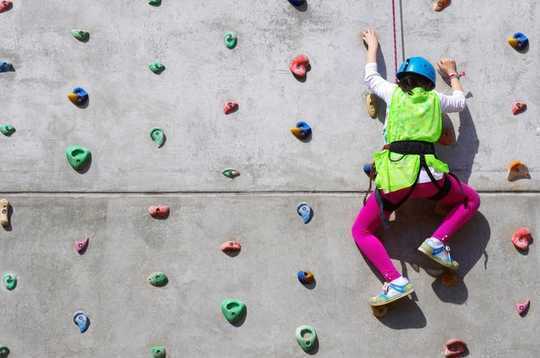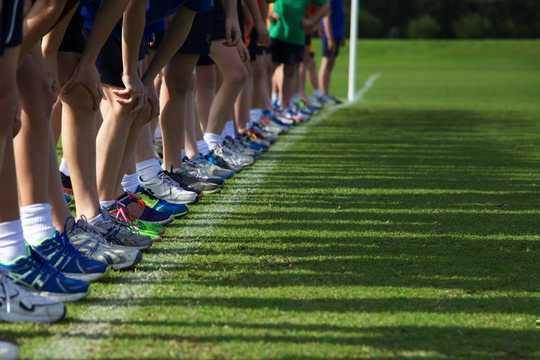For some school children, PE is the best lesson of the week – a chance to leave the desk behind, get outside, and enjoy a run around with friends. For others, it is a frequently miserable experience – a time when they feel degraded, embarrassed, and may even experience physical pain.
Studies have shown that for girls in particular, PE can be a source of distress which leads to them skipping lessons, or missing out on school altogether.
In my own research, I spoke to secondary pupils who both liked and disliked PE, and found that the notion of competitive sport was a clear source of contention. Those who were good at it did not want those less able to “get in the way”, while those less skilled resented being made to compete. They also felt less “liked” by their PE teachers and their more sporty class mates.
Another concern, for boys and girls, was ill fitting and inappropriate clothing and a lack of privacy when changing.
But it’s not game over. Just because a child doesn’t look forward to PE does not mean they never will. Research demonstrates that some simple adjustments can make PE enjoyable for the majority of school children.
For example, a change in emphasis away from competitive sport can swiftly reduce the bullying of less able children. And a move away to prioritising participation over excellence can dramatically increase the confidence (and participation rates) of those less skilled – because it really is the taking part that matters.
If teachers shout or criticise poor performance it can damage the confidence of even the most skilled players. (I once witnessed a PE teacher aggressively – and with no apparent sign of irony – berating some football-playing school boys for making “school boy errors”.)
Instead, PE should be about making sure all children enjoy and take part. If schools value taking part above winning against other schools, the nature of PE changes. When this approach was attempted in one study, it swiftly led to more participation and improved pupil behaviour:
As one pupil commented:
I have actually joined the football team now, because all the violence has gone… Before it was, ‘You lost us the game you ****, it’s all your fault.’ With the new [approach] it is more like we are all in there just trying to get better. No one is to blame. Now it is worth doing.
Other changes implemented in the study gave pupils a say in what sporting activities were available (why not rock climbing or trampolining for instance?). They were also given the opportunity to design the PE kit and reorganise the changing room.
Getting everyone moving
To those who argue we need competitive sport to “build character”, I would point out that there is quite simply no evidence to support this view. But what we can build when we allow young people to work together in a spirit of support and cooperation, is leadership and mutual understanding.
If we need competitive sport to build our national teams, this should happen out of school. PE is about the participation of all – not the excellence of a few, at the expense of the majority.
 Reaching new heights. Shutterstock/Carlos Caetano
Reaching new heights. Shutterstock/Carlos Caetano
At home, the most important thing a parent can do for a child who struggles with PE is to take their concerns seriously. Avoiding a poor PE experience is a perfectly rational thing to do – it is not bad behaviour. But being physically active is extremely important for children and young people, so how, when, and at what level they do it should be primarily their choice.
It is useful if there are opportunities to take part in activities they like outside of the school environment, like a family bike ride or a visit to a swimming pool. My research has shown that when children become more confident in physical activities out of school this increases their confidence in school PE.
If PE continues to cause distress, communication with the school can be key. Maybe the changing facilities could be improved, or the kit requirements relaxed? Old fashioned ideas about PE uniform should not be preventing children from taking part and enjoying physical exercise. There is no reason a child needs to wear shorts or a short skirt to take part in PE.
PE should be a part of school where pupils can interact, work together and get some vital exercise. As it is, children spend far too many hours at school sitting down. The precious little time they have available to move about should be spent doing something active – and which they consider to be fun.![]()
About the Author
Kiara Lewis, Acting Head of Allied Health Professions, Sport and Exercise, University of Huddersfield
This article is republished from The Conversation under a Creative Commons license. Read the original article.
Books on Exercise from Amazon's Best Sellers list
The Four-Pack Revolution: How You Can Aim Lower, Cheat on Your Diet, and Still Lose Weight and Keep It Off
by Chael Sonnen and Ryan Parsons
The Four-Pack Revolution presents a total-life approach for attaining health and fitness goals without the hard work and suffering.
Click for more info or to order
Bigger Leaner Stronger: The Simple Science of Building the Ultimate Male Body
by Michael Matthews
If you want to build muscle, lose fat, and look great as quickly as possible without steroids, good genetics, or wasting ridiculous amounts of time in the gym and money on supplements, then you want to read this book.
Click for more info or to order
The Women's Health Big Book of Exercises: Four Weeks to a Leaner, Sexier, Healthier You!
by Adam Campbell
The Women's Health Big Book of Exercises is the essential workout guide for anyone who wants a better body. As the most comprehensive collection of exercises ever created, this book is a body-shaping power tool for both beginners and longtime fitness buffs alike.
Click for more info or to order
Bodyweight Strength Training Anatomy
by Bret Contreras
In Bodyweight Strength Training Anatomy, author and renowned trainer Bret Contreras has created the authoritative resource for increasing total-body strength without the need for free weights, fitness machines, or even a gym.
Click for more info or to order
The Men's Health Big Book of Exercises: Four Weeks to a Leaner, Stronger, More Muscular You!
by Adam Campbell
The Men's Health Big Book of Exercises is the essential workout guide for anyone who wants a better body. As the most comprehensive collection of exercises ever created, this book is a body-shaping power tool for both beginners and longtime fitness buffs alike.

























